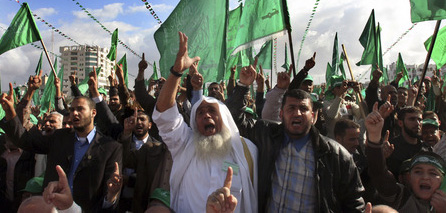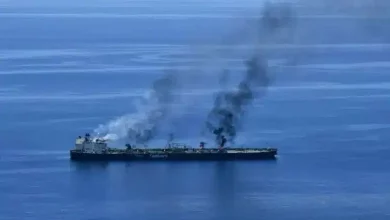Twenty three Years of Hamas struggle to restore rights

In December 1987, the council of the Islamic movement headed by Sheikh Ahmad Yassin met and announced the formal establishment of the Islamic Resistance Movement (Hamas).
The meeting took place on the backdrop of a week of intense popular demonstrations and confrontations with Zionist occupation forces in the Gaza Strip following the death of 4 Palestinian laborers from Jabalia.
The new movement played an active coordination and leadership role in the Intifada. Demonstrations and confrontations with occupation forces were organized in different areas so as to keep the uprising going. In addition, there was further planning to develop the popular uprising into a more intense confrontation that is costly for the occupation. After 2 decades of occupation, Zionist entity was to start paying a heavier price for its crimes.
Over the course of the past 20 years, Hamas has grown into an internationally recognized movement, deriving its recognition from its presence in the street and resistance actions against the occupation. The recognition was never measured by the approval of governments or countries. And so, the movement has become a key figure on the Palestinian scene. All parties looking at that scene know that Hamas is a very important component that cannot be ignored.
However, this recognition has not come easily. Hamas has been pitched in an intense and bloody battle against the occupation. A few months after the establishment of the movement, occupation forces rounded up hundreds of Hamas activists and leaders. A year later, another round up was conducted. The round ups continued; and thousands of Hamas activists and leaders were imprisoned.
Since 1989, Hamas has been carrying out armed resistance activities against the occupation, mainly through the military branch named Ezzedeen Al-Qassam Brigades. In the first few years, Hamas targeted occupation soldiers, settlers, and intelligence officers only. However, the occupation countered that with killing more civilians, culminating with the Ibrahimi Mosque massacre in 1994. On that tragic day, the occupation army killed more Palestinians that the murderer Baruch Goldstein.
And so, Hamas was forced to take the “eye for an eye” approach. The movement stated many times that both sides of the conflict should refrain from targeting civilians. However, the Zionist occupation thought itself above accountability and continued to kill innocent Palestinians. The Palestinian resistance replies were a fraction of the punishment due for the occupation’s crimes.
Over the course of the past 23 years, Hamas has sacrificed the best of its leaders and soldiers in the long struggle against the occupation. Tens of military and political leaders were killed, including the first leader Ahmad Yassin. In addition, thousands of soldiers and members were martyred too.
However, Hamas remained determined to continue along the path of resistance till the full restoration of the legitimate rights of the Palestinian people.
This determination was tested by the Oslo accords, a black mark in the history of the Palestinian struggle for liberation. In a few short negotiating sessions, Palestinian negotiators gave up more than Zionist entity ever dreamed of, while Zionist entity gave up gave up essentially nothing.
Hamas rejected Oslo. And a decade after Oslo, the signatories of that fateful agreement shredded it and stated that Oslo was dead!
But the Hamas rejection of Oslo came at a heavy price. Zionist entity and the Palestinian Authority cooperated in their crackdown on the movement. And while Zionist entity’s crackdown was not strange, the Palestinian crackdown on fellow Palestinians to please Zionist entity was very painful.
But the movement was not swayed by sweet promises, or frightened by angry threats. Hamas remained determined and committed on the path of resistance against the occupation.
The eruption of Al-Aqsa Intifada in 2000 marked a key moment of reform in the Palestinian struggle for freedom. It returned the Palestinian issue to the only track leading to the fulfillment of rights: the road of resistance.
Palestinians tightened their belts and strengthened their resolve. In its effort to crush the Intifada, the occupation was unexceptionally brutal. But Palestinian determination, patience, and belief in their rights were stronger than helicopters, tanks, assassinations, and siege. In the end, the occupation admitted its failure.
The father of settlements dismantled them in Gaza. He conceded that he could not control Gaza from inside. And so, he opted for remote control at the borders. Although this seems more convenient to the occupation, it cannot be denied that Palestinian resistance, led by Hamas, forced the occupation into this option.
Hamas as a movement continues to contribute and sacrifice. However, Hamas must be viewed as it is. It is an Islamic movement working towards the fulfillment of Islam as a way of life in society. It is a link in a long chain of religion, ideology, and civilization that started with our father, Adam (peace and blessings be upon him), and completed with the message Prophet Mohammad (peace and blessings be upon him).
And so, the 23rd anniversary marks the formation of the entity adopted by Muslims in 1987 to intensify the resistance against the occupation of Palestine. The strong foundations and roots extending back to Prophet Mohammad (peace and blessings be upon him) have made this struggle successful in the face of overwhelming oppression. And on the contemporary level, Hamas was formed by the Muslim Brotherhood in Palestine, popularly known as Al-Mujam’a Al-Islami before December 1987. And that is influenced by the reforms of Hasan El-Banna and the Muslim Brotherhood in Egypt, which go back to 1928.
The chain of Jihad goes back centuries into a rich tradition. And it extends generations in the future till the fulfillment of the legitimate rights of the Palestinian people. Nothing can erase these rights; and no one is entitled to concede them. And so the future holds more sacrifice and suffering, culminated by freedom and victory, for the Palestinian people.







